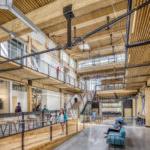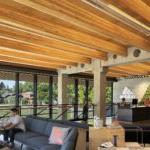专家建议
木结构建筑需要考虑热运动吗?
Accommodating thermal movement isn’t generally considered necessary, but designers of wood-frame buildings should account for expansion during construction due to increased moisture exposure.

The general consensus is that designers of wood-frame buildings do not need to account for thermal movement, as thermal expansion is offset by the shrinkage of wood due to increased temperatures and moisture loss—which designers do need to consider.
While concrete and steel buildings are typically designed with expansion joints to account for thermal movement due to environmental temperature fluctuations, 木材的热膨胀系数明显较低. 木 可以 体验温度变化的空间运动. 正如美国农业部林产品实验室的第4章所述 木头手册, “The thermal expansion coefficients of completely dry wood are positive in all directions; that is, 木材受热膨胀,受冷收缩.” However, moisture fluctuations impact dimensional movement of the wood at the same time.
木 is hygroscopic, meaning it has the ability to absorb and release moisture. As this occurs, it also has the potential to change dimensionally. Note that the above excerpt from the 木头手册 references completely oven dry wood (0% moisture content, 或MC). 木 used for the structure of a building isn’t completely oven-dry during or even after construction. 随着木材温度的升高, 它可能会经历一些热膨胀, 但同时也失去了MC. The shrinkage due to reduced MC is more signifi可以t than the expansion due to increased temperature; therefore, 最终的结果是收缩. The following section from Chapter 4 of the 木头手册 explains this:
“木 that contains moisture reacts differently to varying temperature than does nearly oven-dry wood. 当潮湿的木头被加热时, it tends to expand because of normal thermal expansion and to shrink because of loss in moisture content. Unless the wood is very dry initially (perhaps 3% or 4% moisture content or less), shrinkage caused by moisture loss on heating will be greater than thermal expansion, 所以加热的净尺寸变化是负的. 木 at intermediate moisture levels (about 8% to 20%) will expand when first heated, and then gradually shrink to a volume smaller than the initial volume as the wood gradually loses water while in the heated condition.”
木 shrinkage/expansion occurs most notably perpendicular to the grain, meaning that a solid sawn wood stud or floor joist will change in width and depth. Longitudinal dimensional change due to moisture change is negligible, meaning the length of a stud or floor joist will essentially remain unchanged. 正如《皇冠2登录welcome》所指出的:
“即使在纵向(晶粒)方向, where dimensional change caused by moisture change is very small, such changes will still predominate over corresponding dimensional changes as a result of thermal expansion unless the wood is very dry initially. 适用于通常湿度下的木材, net dimensional changes will generally be negative after prolonged heating.”
第四节.4 the Ameri可以 木 Council’s 国家 Design Specification® (NDS®) for 木 Construction 手册 还提供了对这一主题的评论, and includes coefficients of thermal expansion for a number of wood species.
While accommodating thermal movement isn’t generally considered necessary, it is recommended that designers of wood-frame buildings account for expansion during construction due to increased moisture exposure. It is especially important to consider expansion of wall, floor and roof sheathing. Because panel products start at a low moisture content (~8-12% MC) and are directly exposed to the elements during construction (in many cases increasing to >19% MC), 这些产品的扩张可能更为明显. 板屈曲, 当没有面板扩展的空间时会发生什么, is prevented with a standard 1/8-inch space between all sheathing panel edges and end joints as recommended by APA in Technical Note D481N 尽量减少木制结构板的屈曲. 在较大的建筑物中(长度超过80英尺), it is recommended to increase the gap between panels and take additional construction sequencing precautions to avoid panel buckling. 木工纸, 多层木结构的收缩调节,讨论了这个问题,技术说明U425也是如此 大型建筑物的临时伸缩缝 从美国心理学协会.



